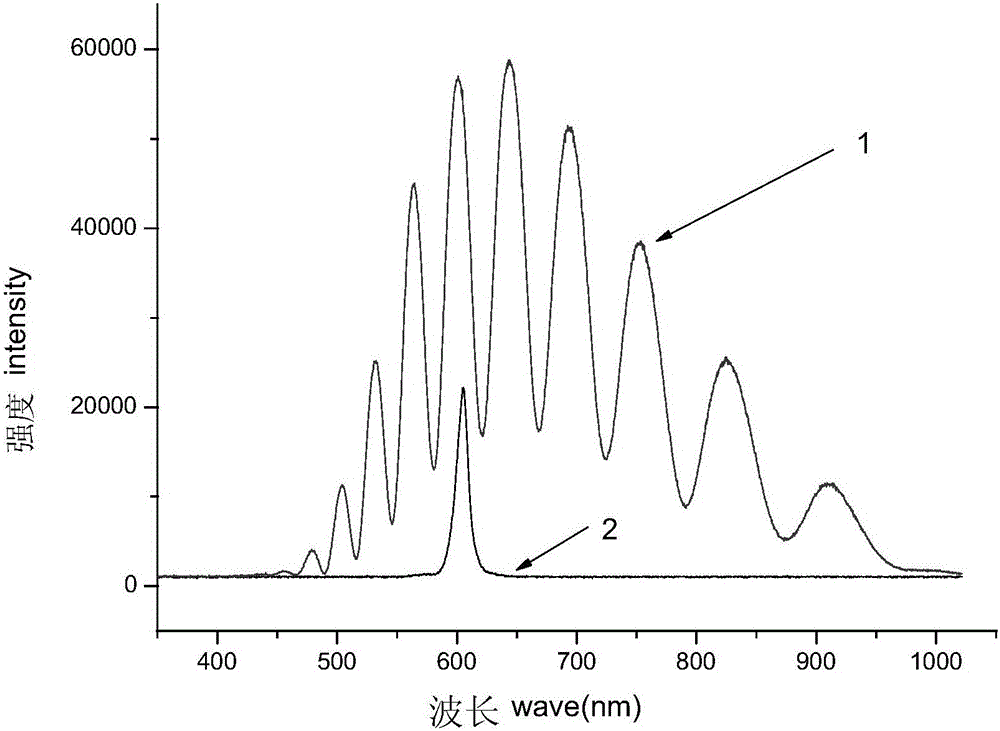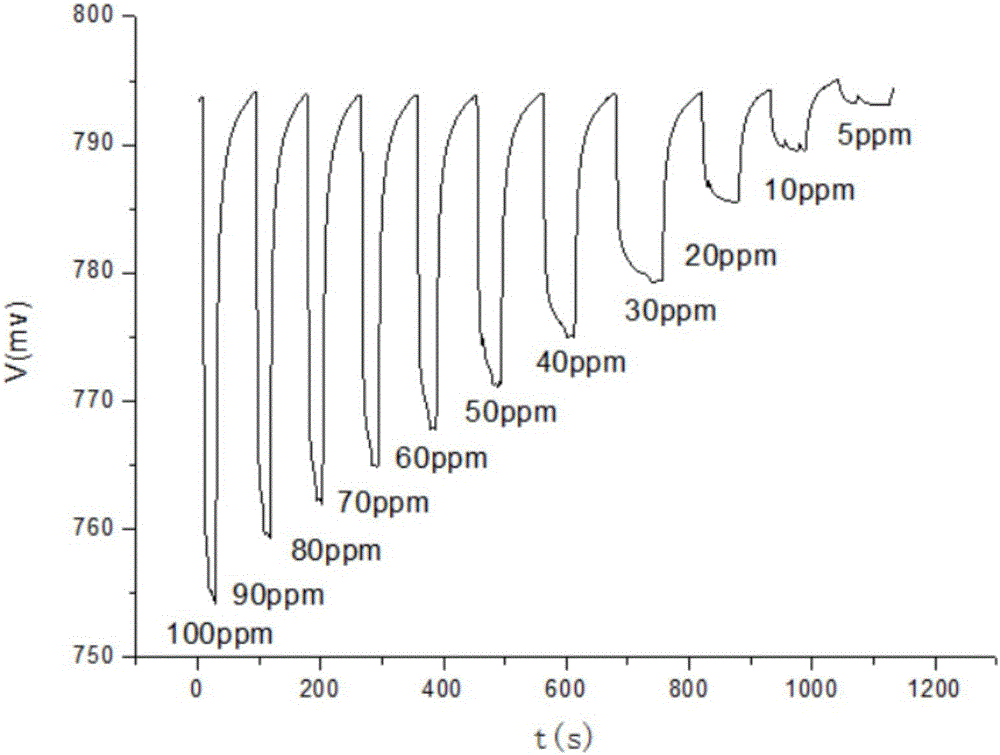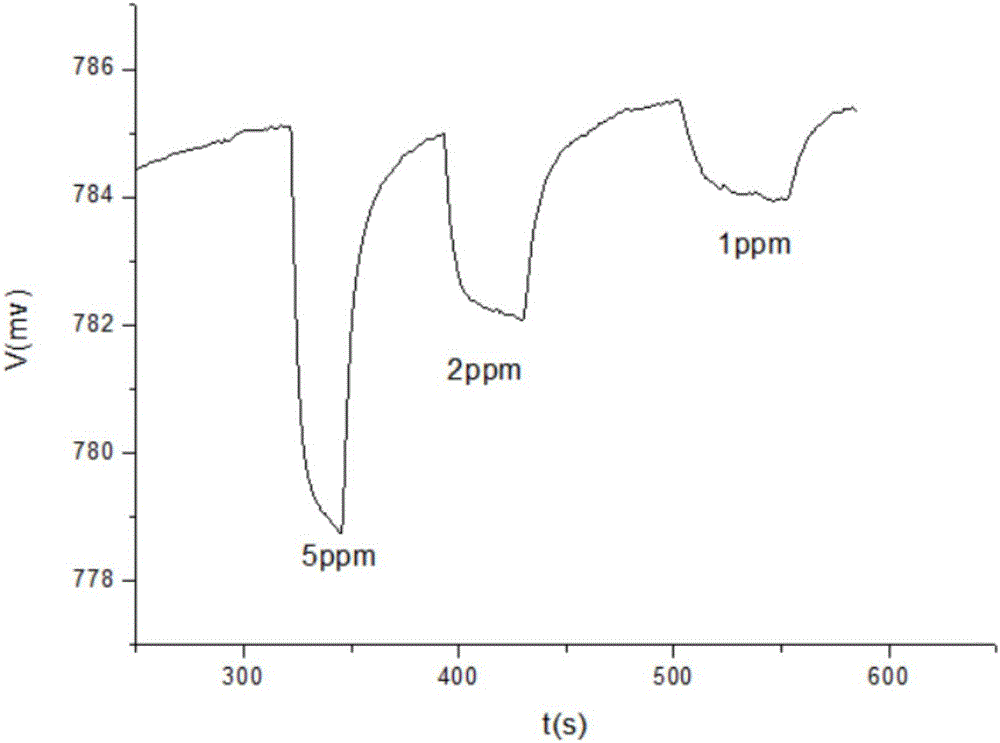Method for preparing high-sensitivity optical ammonia sensitive material
A sensitive and optical technology, applied in the field of ammonia-sensitive materials, can solve the problems of difficult industrialization, complex process and high production cost, and achieve the effects of easy industrialization, simple process flow and fast response speed.
- Summary
- Abstract
- Description
- Claims
- Application Information
AI Technical Summary
Problems solved by technology
Method used
Image
Examples
Embodiment 1
[0036] Preparation of nanoporous materials: use a mixed solution of hydrofluoric acid / ethanol / glycerol with a volume ratio of 3.5:1:0.005 as the electrolyte for direct current etching with an average etching current of 20mA / cm 2 , The etching time is 1200s, after etching, rinse with ethanol and blow dry with nitrogen to obtain nanoporous material.
[0037] Preparation of the porous material carrier: the nanoporous material was oxidized at 550° C. for 1 hour to obtain the porous material carrier.
[0038] Preparation of ammonia-sensitive material: mix bromothymol blue into a 0.1% by mass ethanol solution to form an ethanol solution of bromothymol blue, and then mix with a 2% by mass acetic acid aqueous solution in a volume ratio of 10:0.5 for protonation After chemical treatment, it is loaded onto the surface of the porous material carrier by spin coating and dried in a vacuum oven to obtain a highly sensitive optical ammonia sensitive material.
[0039] The ammonia sensor made of thi...
Embodiment 2
[0041] Preparation of nanoporous materials: use a mixed solution of hydrofluoric acid / ethanol / glycerol with a volume ratio of 3.5:1:0.0005 as the electrolyte for direct current etching with an average etching current of 100mA / cm 2 , The etching time is 200s, after etching, rinse with ethanol and blow dry with nitrogen to obtain nanoporous material.
[0042] Preparation of porous material carrier: the nanoporous material is oxidized at 450° C. for 3 hours to obtain the porous material carrier.
[0043] Preparation of ammonia sensitive material: mix bromocresol green into a 1% ethanol solution by mass to form an ethanol solution of bromocresol green, and then mix it with a 2% mass% acetic acid solution in a volume ratio of 10:2 to perform protons After chemical treatment, it is loaded onto the surface of the porous material carrier by dip dyeing, and dried in a vacuum oven to obtain a highly sensitive optical ammonia sensitive material.
[0044] The ammonia sensor made of this ammonia-...
Embodiment 3
[0047] Preparation of nanoporous materials: use a mixed solution of hydrofluoric acid / ethanol / glycerol with a volume ratio of 3.5:1:0.0025 as the electrolyte for direct current etching with an average etching current of 60mA / cm 2 , The etching time is 600s, after etching, rinse with ethanol and blow dry with nitrogen to obtain nanoporous material.
[0048] Preparation of the porous material carrier: the nanoporous material is oxidized at 400° C. for 5 hours to obtain the porous material carrier.
[0049] Preparation of ammonia-sensitive material: mix bromophenol blue into 0.5% by mass ethanol solution to form bromophenol blue ethanol solution, and then mix with 2% by mass acetic acid solution in a volume ratio of 10:1.5 to perform protonation treatment Then, it is loaded onto the surface of the porous material carrier by drip coating, and dried in a vacuum oven to obtain a highly sensitive optical ammonia sensitive material.
[0050] The ammonia sensor made of this ammonia-sensitive ...
PUM
 Login to View More
Login to View More Abstract
Description
Claims
Application Information
 Login to View More
Login to View More - R&D
- Intellectual Property
- Life Sciences
- Materials
- Tech Scout
- Unparalleled Data Quality
- Higher Quality Content
- 60% Fewer Hallucinations
Browse by: Latest US Patents, China's latest patents, Technical Efficacy Thesaurus, Application Domain, Technology Topic, Popular Technical Reports.
© 2025 PatSnap. All rights reserved.Legal|Privacy policy|Modern Slavery Act Transparency Statement|Sitemap|About US| Contact US: help@patsnap.com



